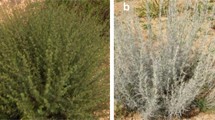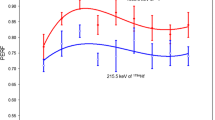Abstract
Nineteen natural herbs and two prescriptions prepared from mixed herbs were analyzed via epithermal neutron activation analysis (ENAA) to evaluate their bromine and iodine concentration. Traditional medical doctors prescribed the samples presented in this work to most Taiwanese children for strengthening their immune systems. Empirical results indicated a wide diversity of bromine in the samples. Yet, the iodine concentration was only around one to tenth or twentieth of the bromine. The maximum daily intake (MDI) for various medical herbs was also widely diversified from one to tenfold on the basis of various criteria. The minimum detectable concentration (MDC) of bromine and iodine found was 0.42±0.14 ppm and 0.067±0.016 ppm, respectively. Compared to that from conventional thermal neutron activation analysis (NAA) for a similar evaluation, the extremely low MDC obtained here was attributed to the large amount of thermal neutron absorption during sample irradiation.
Similar content being viewed by others
References
E. J. Wayne et al., Clinical Aspects of Iodine Metabolism, Blackwell, Oxford, 1964.
A. Mannan et al., J. Radioanal. Nucl. Chem., 162 (1992) 111.
I. Kunugigama et al., J. Radioanal. Nucl. Chem., 165 (1992) 309.
P. Bratter, F. Chisela, Anal. Chim. Acta, 188 (1986) 85.
M. B. A. Vasconcellos, V. A. Maihara, J. Radioanal. Nucl. Chem., 122 (1988) 161.
S. Yoshida, Y. Muramatsu, J. Radioanal. Nucl. Chem., 169 (1993) 73.
R. M. Parr, A. Chatt, M. F. Reis, M. Abdulla, Biol. Trace Element Res., (1994) 481.
L. K. Pan, C. Y. Chen, Food Chem., 72 (2001) 255.
M. Ou, Chinese-English Manual of Common Used Prescription in TCM, Ngai Kwong, Hong Kong, 1993.
S. Glasstone, A. Sesonke, Nuclear Reactor Engineering, Vol. 1, Van Nostrand Reinhold, Inc., New York, 1967, Chapter 4, p. 152.
E. E. Chang, J. Y. Yang, C. F. Wang, M. J. Duo, J. Radioanal. Nucl. Chem., 211 (1996) 333.
W. G. Vernetson, R. T. Ratner, J. Radioanal. Nucl. Chem., 192 (1995) 351.
G. F. Knoll, Radiation Detection and Measurement, John Wiley and Sons, New York, 2nd ed., 1989.
V. S. Shirley, C. M. Lederer, Table of Isotopes, Wiley-Interscience Publishing Co., New York, 1978.
X. Hou et al., Fresenius J. Anal. Chem., 357 (1997) 1106.
M. D. Glascock et al., J. Radioanal. Nucl. Chem., 92 (1985) 379.
S. J. Parry, H. Malik, Analyst, 117 (1992) 1945.
L. A. Currie, Anal. Chem., 40 (1968) 586.
Author information
Authors and Affiliations
Rights and permissions
About this article
Cite this article
Chen, CY., Wei, YY., ChangLai, SP. et al. Bromine and iodine in Chinese medical herbs determined via epithermal neutron activation analysis. Journal of Radioanalytical and Nuclear Chemistry 257, 405–410 (2003). https://doi.org/10.1023/A:1024708518645
Issue Date:
DOI: https://doi.org/10.1023/A:1024708518645




